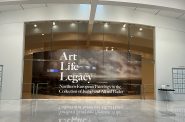The art of conservation via Watershed Milwaukee
According to Raoul Deal, water is gold.
Deal, who teaches in the Department of Visual Art at the University of Wisconsin-Milwaukee, is the co-curator of Watershed Milwaukee, a three-pronged two-year project consisting of community outreach and public art interventions, all culminating with a final gallery exhibit.
When Nicolas Lampert, a Milwaukee-based interdisciplinary artist who teaches courses at UWM on Art and Urban Ecology, extended the invitation to start the multi-dimensional project, Deal jumped at opportunity.
“I’m not a water expert,” Deal said. “But I concentrate on community activism, and these issues need attention.”
The project, as a collective form of art activism, aims to address the shifting ecological and political dimensions of water by using art as a primary form of communication. Artists facilitating the interventions are as diverse in location and age as the art forms in which they choose to express themselves – everywhere from Mexico to Milwaukee, Chicago to Minneapolis, and ranging in age from 22-60.
Among them are Allison Westbrook and Jenny Plevin, a couple who will be giving canoe rides around the pond in Washington Park on July 28 from 6-10 p.m. As the canoes skim the water, there will be numerous illuminated bottle-like objects floating around with cryptic messages inside – messages about water and its impact on all of us.
“The idea stems from the whole ‘message in a bottle’ plea, combining with the magical element of light on water,” Westbrook said. “We want people to be interactive and learn in a different environment.”
Westbrook says places like Washington Park are underutilized and hopes that the canoe rides can supplant the “save the planet” lecture that the public is used to.
“A lot of people are inclined to ignore things when they are told over and over again,” Westbrook says. “But people like sparkly and shiny things.”
One of the neighborhoods that caught Deal’s attention was the Walnut Way Conservation Corps, which has spent the last 6 years re-building its community, mainly through urban gardening. Deal was inspired by the words of Sharon Adams, a Walnut Way community organizer: “Access flows to stewardship.”
Last fall, Deal and Lampert installed a permanent silk-screening facility at Bruce Guadalupe Middle School, where students learned about water issues and came up with their own drawings.
“The artistic process of prints is a historical tradition,” Deal said. “There are multiples, similar to the way newspapers first functioned – it spreads a message.”
Among these drawings were images of the kids protesting outside Coca Cola headquarters alongside statements like “Community is growth” and “Stop killing our lakes”— pretty profound stuff for middle schoolers.
“The cool thing was [that] the kids came up with ideas on their own,” Deal said. “Later they went home to talk to their parents about it, which gets them involved and spreads the education.”
Deal will combine and rework the prints into a mural installed in the alley that runs along the side of the Walnut Way neighborhood house. The work will be formally unveiled Oct. 2 during the neighborhood’s annual Harvest Day.
Lampert, however, focuses more on atypical art that has a political angle to it. He is a frequent contributor to Just Seeds artist’s cooperative and as a result, is part of a large network of art activists. In 2008, he curated Seeing Green: Art, Ecology and Activism in Milwaukee, which consisted of projects focusing on sustainability submitted by 40 local artists.
Both Lampert and Deal teach classes on social justice issues as well, which has impacted the project enormously.
“It’s difficult to explain the project in sound bytes because it’s so multi-faceted,” Lampert said. “It’s important when art becomes political because it starts conversations in a unique way.”
Earlier this month, Lampert created signs in remote locations around Milwaukee to raise questions about water issues. One asks, “Who owns water?” Lampert said when people saw him putting up the signs they started to inquire about them right away.
“I’m interested in posing open-ended questions, to which any response can start a conversation immediately,” Lampert said.
Whether it’s the Guadalupe Middle School silk-screen prints showing up on kids’ t-shirts, or projected images of water onto Milwaukee’s Hoan Bridge by artists Xavier and Maria Cristina Tavera, art activism is showing up all over the area.
“Art is a vehicle,” Deal said. “You find it in places you don’t expect.”
Deal says it is crucial that Milwaukee acts now, at a time when the city is attempting to situate itself for economic prosperity. According to Deal, if the community is not informed, corporate interest could take over in an industrial fashion.
Communities like Walnut Way, which has installed nearly 40 rain gardens, are certainly not underestimating the importance of water issues. Since 75 percent of the pollution in streams, rivers and lakes is carried there by storm water, the urban gardening movement contributed in a concrete way to the reduction of the contamination of Milwaukee’s watershed.
In the midst of explaining Walnut Way’s activism, Deal conjures up the thought of a city ordinance for rain barrels.
“People building up within a neighborhood is exciting,” Deal said. “It’s the idea of elevating the positive and pushing back the negative.”
Lampert says there is amazing environmental work happening all over the city and the final show will help communicate some of those efforts. Both Lampert and Deal say they would love to see the project travel to various Midwest cities.
“The show will live on in many ways,” Lampert said. “Artists are inspiring each other and those around them, and it is definitely starting conversations.”
Visit the Watershed Milwaukee online for more information.
Art
-
Exhibit Tells Story of Vietnam War Resistors in the Military
 Mar 29th, 2024 by Bill Christofferson
Mar 29th, 2024 by Bill Christofferson
-
See Art Museum’s New Exhibit, ‘Portrait of the Collector’
 Sep 28th, 2023 by Sophie Bolich
Sep 28th, 2023 by Sophie Bolich
-
100 Years Of Memorable Photography
 Sep 18th, 2023 by Rose Balistreri
Sep 18th, 2023 by Rose Balistreri




















Great job, Kelly! Really interesting.